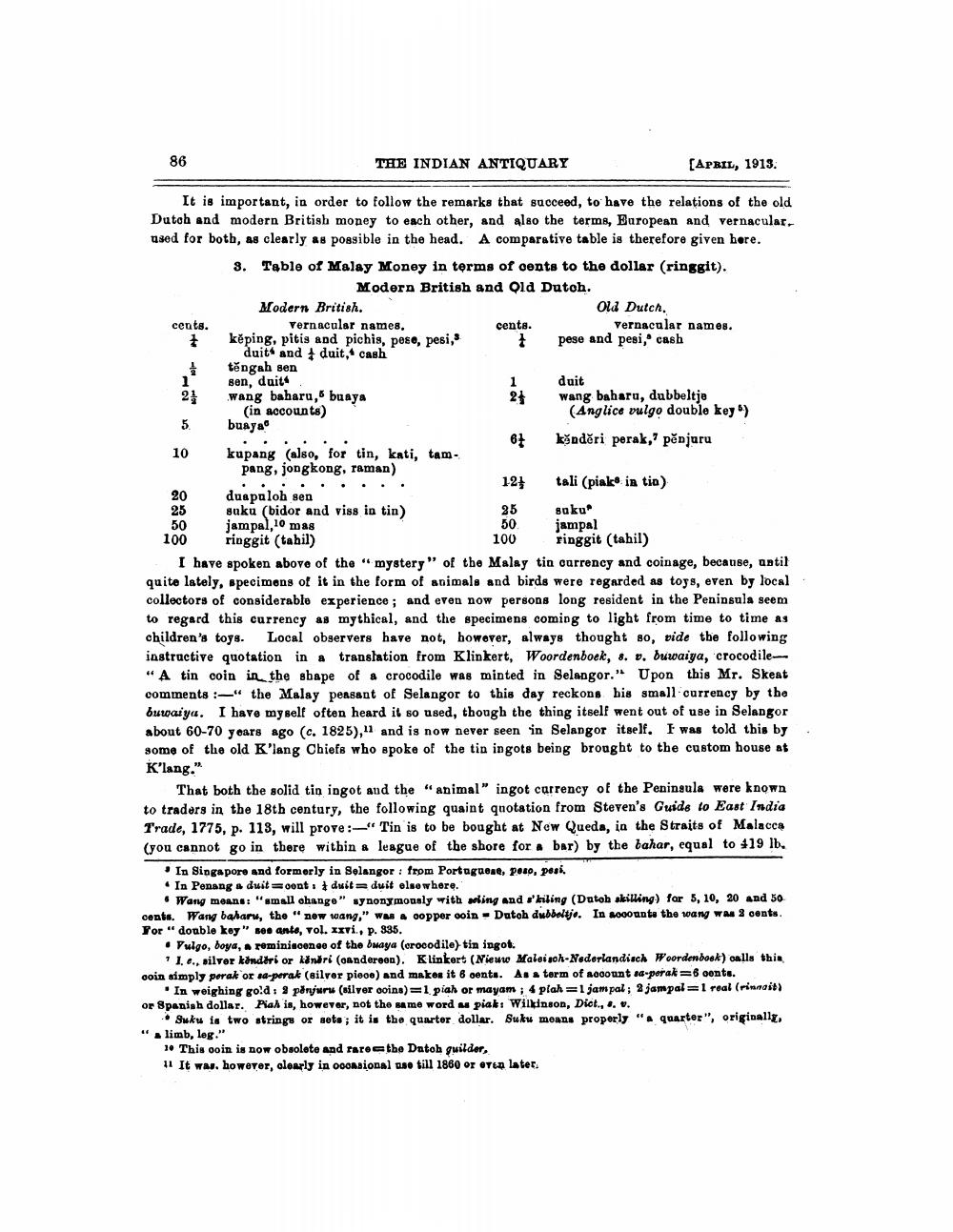________________
86
THE INDIAN ANTIQUARY
[APRIL, 1913.
cents.
-
-
50
100
It is important, in order to follow the remarks that succeed, to have the relations of the old Dutch and modern British money to each other, and also the terms, Buropean and vernacular. used for both, as clearly as possible in the head. A comparative table is therefore given here. 3. Table of Malay Money in terms of cents to the dollar (ringgit).
Modern British and Old Dutoh. Modern British.
Old Dutch. vernacular names.
cente.
vernacular names. keping, pitis and pichis, peso, pesi,
pese and pesi, cash duit and duit, cash těngah sen sen, duits
duit wang baharu, buaya
wang baharu, dubbeltje (in accounts)
(Anglice vulgo double key buaya
67 kšnděri perak, penjuru kupang (also, for tin, kati, tampang, jongkong, raman)
12 tali (piakin tio) 20
duapaloh sen suku (bidor and viss in tin)
25 saku jampal, 10 mas
50 jampal ringgit (tahil)
100 ringgit (tahil) I have spoken above of the mystery" of the Malay tin currency and coinage, because, antil quite lately, specimens of it in the form of animals and birds were regarded as toys, even by local collectors of considerable experience; and even now persons long resident in the Peninsula seem to regard this currency as mythical, and the specimens coming to light from time to time as children's toys. Local observers have not, however, always thought so, vide the following instructive quotation in a translation from Klinkert, Woordenboek, 8. o. buwaiya, crocodile"A tin coin in the shape of a crocodile was minted in Selangor." Upon this Mr. Skeat comments :-" the Malay peasant of Selangor to this day reckons his small currency by the buwalya. I have myself often heard it so used, though the thing itself went out of use in Selangor about 60-70 years ago (c. 1825), and is now never seen in Selangor itself. I was told this by some of the old Klang Chiefs who spoke of the tin ingots being brought to the custom house af K'lang."
That both the solid tin ingot and the "animal" ingot currency of the Peninsula were known to traders in the 18th century, the following quaint quotation from Steven's Guide to East India I'rade, 1775, p. 113, will prove :-- Tin is to be bought at New Queda, in the Straits of Malacca (you cannot go in there within a league of the shore for a bar) by the bahar, equal to 419 lb.
• In Singapore and formerly in Selangor : from Portuguese, poso, posk • In Penang & duit=cont: duit=duit elsewhere.
• Wang means: "small change" synonymously with wing and s'kiling (Dutoh akilling) for 5, 10, 20 and 50 cents. Wang baharu, the "new wang," WAS * Opper coin - Datoh dubbeltjo. In account the wand was 8 cents. For "double key" seo ante, vol. xxvi.. p. 335.
• Pulgo, boya, reminiscence of the buaya (crocodile) tin ingot.
11. e., silver kondari or keniri (andereen). Klinkert (Nieuwe Maloi soh-Nederlandisch Woordenboek) calls this coin simply perak or sa-perak (silver piooo) and makes it 6 cents. Au term of account sa-porak = oonts.
In weighing gold: pönjuru (silver coins)=1 piah or mayam ; 4 plah 1 jampal; 2 jampal=1 real (rinngit) or Spanish dollar. Mial is, however, not the same word as piak: Wilkinson, Dist., ...
Suku ia two strings or aeta; it is the quarter dollar. Suku moans properly "a quarter", originally, ", limb, leg."
1. This coin is now obsolete and rares the Datoh guilder, 11 It was, however, clearly in consional use till 1860 or even later.




